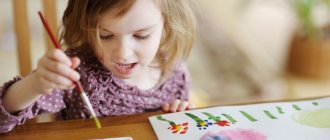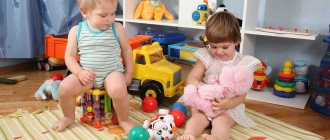The long-awaited moment has arrived: your baby has celebrated his first birthday. This year has been filled with excitement, anxiety and unforgettable moments of happiness. How happy parents are with the skills acquired by the baby! Nevertheless, every attentive and caring mother asks herself the following questions at this milestone: “What can a child do in a year? Is there anything important missing?”
Don't worry if your child's scores don't match the list below 100% (these are averages). Perhaps your baby will be somewhat behind or, on the contrary, ahead of this list of norms. The skills and abilities of a child at the age of one depend on many factors, including character traits, heredity and how much attention close relatives give him.
Work with your baby - he will soon succeed. Children who have been striving to develop since birth are often ahead of the average, which is a source of special pride for parents.
Physical development of a child at 1 year
The pace of the baby’s physical development begins to slow down after 12 months. The baby's height and weight will not increase as quickly as it did in the first months of life. These indicators must be recorded every 1-3 months to ensure that the child’s development does not deviate from the norm.
Table of weight and height of a child from 1 year to 2 years by month
| Month | Girl | Boy | ||
| Height | Weight | Height | Weight | |
| 12 (1 year) | 73,8 | 9,5 | 75,5 | 10,3 |
| 13 (1 year 1 month) | 75,0 | 9,8 | 76,8 | 10,6 |
| 14 (1 year 2 months) | 76,1 | 10,1 | 78,0 | 10,9 |
| 15 (1 year 3 months) | 77,2 | 10,3 | 79,0 | 11,1 |
| 16 (1 year 4 months) | 78,3 | 10,6 | 80,0 | 11,3 |
| 17 (1 year 5 months) | 79,3 | 10,8 | 81,0 | 11,5 |
| 18 (1 year 6 months) | 80,3 | 11,0 | 82,0 | 11,7 |
| 19 (1 year 7 months) | 81,3 | 11,2 | 83,0 | 11,9 |
| 20 (1 year 8 months) | 82,2 | 11,4 | 83,9 | 12,1 |
| 21 (1 year 9 months) | 83,1 | 11,6 | 84,7 | 12,2 |
| 22 (1 year 10 months) | 84,0 | 11,7 | 85,6 | 12,4 |
| 23 (1 year 11 months) | 84,9 | 11,9 | 86,4 | 12,6 |
| 24 (2 years) | 85,8 | 12,1 | 87,3 | 12,7 |
Height and weight parameters may not fit into the norm; this may be either a delay in growth or an increase in the parameters averaged by pediatricians. Each child grows and matures on his own schedule. We can talk about a violation of the pace of development only when the child has an abnormally low or high height/weight compared to his peers.
The main points on increasing the height and weight of a baby by one year, how many times does a one-year-old child eat and what skills does he begin to master at this age are also discussed in this video:
Body proportionality
A baby’s appearance changes more every year than their body size. The largest parts of the body of a one-year-old baby are the head and tummy, which protrudes forward. The face has rounded, soft contours. The child's arms and legs are short and soft relative to the body, without a hint of muscularity.
Increase in head volume
The head circumference at this age reaches 46.6 cm and by one and a half years it increases to 47.9-48 cm. During the second year of life, the head volume can increase by 2.5 cm. By the age of two, the baby’s head size will be almost 90% of standard adult head size.
Number of teeth
This indicator largely depends on heredity.
The amount of calcium in the body is also important. On average, the figure can vary from 4-6 to 10 teeth erupted. It is important that the baby’s diet includes dairy products (breast milk, baby cottage cheese, kefir), as well as vitamin D. Note! A pediatrician can assess the physical development of a child at one year on the basis of proportionality, which is taken into account along with body weight and length. A well-built baby has a chest circumference greater than the head circumference by a number of centimeters equal to the child’s age.
Differences in the development of boys and girls per year
According to standard WHO data, children of different sexes have different height and weight parameters. You can compare indicators from one year to two years by month using the table above. Height and weight per year according to average WHO data for one-year-old babies are as follows:
- Boys. Weight – from 10.0 kg to 10.9 kg. Height – from 75.3 to 78 cm.
- Girls. Weight – from 9.0 kg to 10.6 kg. Height – from 74.0 to 77.4 cm.
As for skills, boys and girls develop them at approximately the same rate, although, according to experts, girls may begin to speak earlier. Also, some studies suggest that boys are more active and mobile in games, but this difference is not very significant.
Helpful information
When a baby appears in a family, new parents have many questions. Some people are concerned about the reflexes of newborns, and some parents are actively waiting for the moment when the baby begins to hold his head up. There are those who are worried about the vision of a newborn and are trying to find information about when a baby begins to see. You can also familiarize yourself with this information.
What educational activities for children from 1 year old have you used for your baby? What did your child like to play with at this age? We will be glad if you share your interesting and funny stories, as well as useful and practical tips. And don’t forget to leave comments about the article you read.
First achievements - what skills does a child master by the age of one?
Knowing what skills a baby should master by 12 months, parents will be able to better understand their child and come to his aid if any difficulties arise. It's worth remembering: the more complex the skill, the longer it will take to master it. For example, a baby can take his first steps at both 11 and 15 months. If you notice the prerequisites for your child to master new skills, then real success is not far off.
| Table of development of basic skills in a child aged 1 year | |
| Hearing | Recognizes the sounds of objects (washing machine, clock, telephone) and simple melodies; tries to imitate sounds (a car is driving - “zhzhzh”) and animal voices (a cow mooes - “muuu”). |
| Speech | Pronounces about 10 words (including babbling); imitates sounds from the environment. |
| Motor skills | Takes independent steps without support; crouches and bends over. |
| A game | He examines his reflection in the mirror with interest; draws short strokes and dots on paper; at the request of an adult, he can show parts of his body. |
| Emotions | Treats others differently; reacts to the word “no”; begins to empathize. |
| Social development | The child understands and fulfills simple requests (give/take); points a finger at an object of interest; holds a cup of water and drinks from it; puts his feet into shoes. |
Achievements of the first 12 months
By the time of 12 months, the baby arrives with certain achievements.
Here's what a year-old child can most often do:
- observes with the eyes a moving object or light;
- follows the sound and object of the toy with his eyes, pulls his hands towards it;
- smiles;
- holds his head upright;
- quickly and deftly rolls over from one side to the other, onto the stomach and back onto the back;
- sits and stands confidently with support, takes the first steps;
- hums, pronounces the first syllables and words.
Speech of a child at 1 year
From the age of one year, a child begins to understand literally everything that an adult tells him. The child's responsiveness encourages communication with him. With a one-year-old baby, you can gradually learn to name objects, colors, body parts, without replacing their correct name with “childish” language. By setting an example of correct speech from a young age, you will help your child learn to pronounce words with a minimum of difficulty.
Key points in speech development at this age:
- Points with his finger objects or pictures in the book that his parents call him (“where is the ball?”, “Show me the dog!”).
- Says a few simple words (by 15-18 months);
- Follows simple instructions and requests (“let’s go have breakfast”, “bring the doll”);
- Tries to repeat the words he hears;
- Expresses denial by shaking his head (“no”).
It may take time before you learn to understand your baby, including his gestures. Remember, you should never laugh at your baby’s speech mistakes, even if you find them funny. The pronunciation will gradually improve, you just need to be patient and attentive to your child.
Communication
Auditory perception and speech skills are improving more and more every month. Soon the baby will become a full-fledged interlocutor with his own opinion and interesting questions that will confuse any adult. In the meantime, the child can:
- speak about a dozen words;
- understand the meaning of the question, answer with words, sounds, gestures, movements;
- repeat the intonation of adults and reproduce it in similar situations;
- show and bring objects that the baby is asked about;
- fulfill requests made to him;
- know loved ones by name;
- understands the meaning of the words “cannot” and “possible.”
Often in a child’s speech there is not the whole word, but the first or stressed syllable. But you speak to your child in the right words, and do not repeat simplifications after him. Make communication with your child constant. Do not ignore a single interrogative sound, because the more words and their meanings you hear, the faster your speech will fill and improve.
Not without difficulties: the crisis of 1 year of life
At twelve months, the child begins to experience a “crisis of negativism,” which manifests itself fully by the age of two. Its existence can be guessed by some signs:
- the baby demonstrates disobedience, stubbornness, and becomes uncontrollable;
- the child’s behavior is inconsistent and cannot be predicted;
- the desire for independence and independence is clearly expressed.
The fact is that during the second year of life, a child is in a constant desire to take independent steps, but at the same time keep his mother close to him. He can move away from his parent and test his abilities and skills “in action.” But the thought that he is a separate independent person frightens the baby. He needs a lot of care and warmth, especially when the child is tired, offended, or not feeling well.
How to cope with the emotional instability of a baby?
Provide your child with physical contact as often as possible. Your goal is to strengthen his sense of security and well-being. Sit nearby, hug, be attentive to the baby’s mood. React when he is happy and when he is upset. Support and the necessary discipline will help the child overcome a difficult period.
Important! Explaining the rules of behavior or punishing a baby a year is completely useless. The child simply will not understand you, and regular such actions will lead to anger and aggression on his part. The best way to help your one-year-old regain his confidence is to give him the support and attention he needs.
We also recommend watching a video with the experience of a young mother who talks about the achievements of her one-year-old baby:
Who is the head in this house
At home, in everyday life, your son or daughter begins to feel like little masters, full-fledged members of the family. They strive to reach every shelf, touch and taste every thing. Now you need not to hinder, but to help your researcher learn more and more new things. Involve him in your household chores.
Let me sprinkle the flour from glass to glass in the kitchen, dig into the buckwheat and peas, ask for help in wiping off the dust and washing the toys. All this contributes to the development of fine motor skills, and therefore speech. In addition, the baby gets used to helping you, he has his own responsibilities at home. Now we need to teach him to brush his teeth, wash his face and hands, and eat on his own using a spoon and fork. You will be surprised how quickly your son or daughter will master these wisdom. Especially if you lead by example.
How a baby discovers the world
Now your baby is actively interested in the “details of the world,” which begins with his own toys. He may strive to assemble and disassemble something, and watch how adults do it.
“Manual skills”, what a child should be able to do at 1 year:
- “work” with a pyramid consisting of several rings: disassemble it and assemble it;
- build a house by placing a couple of cubes on top of each other;
- is interested in the design of objects with lids - boxes, saucepans; can put other objects in them and cover them with lids;
- is interested in sorter toys, into the holes of which you can push an object; you can make such a homemade “sorter” from an ordinary box by cutting a round or rectangular hole in it;
- if you put an empty plate and cup in front of him, he can “drink” or “eat” from it, “like a toy,” showing that he knows how to do this;
- can take a toy as it is convenient for him - with one or two hands, and with two fingers, transfer it from one hand to another;
- understands that objects can move (car, ball, stroller, etc.) and therefore strives to roll them;
- plays with the doll: feeds it, puts it in the crib, combs its hair, etc.;
- plays with his things - slippers, hat, etc.;
- can use the closet independently: open and close a drawer or door, take out toys or things and put them in the closet;
- tries to repeat what other children or adults do: clap their hands, knock on an object, dig sand with a shovel, etc.;
- copies the actions of adults: wipes the dust like mom or fixes the faucet like dad.











